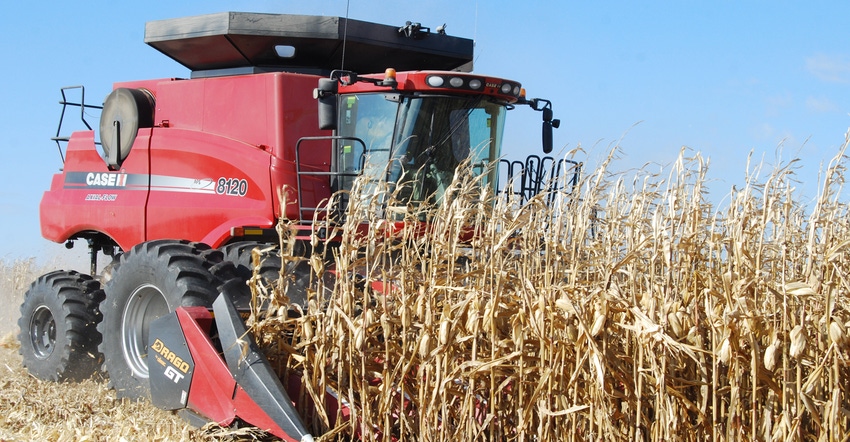October 29, 2018

Amid the hustle of harvest season, corn producers are pressed to make daily decisions that impact their profit per acre. Hitting the right harvest windows, accounting for weather delays and having the right harvest equipment to handle a multitude of field conditions are among the many factors producers must consider to maximize yield and minimize losses.
“Producers have to be ready to react to a variety of harvest conditions. This year, rapid crop maturity took many farmers by surprise and excessive rainfall early in the season limited the number of days suitable for fieldwork,” says Denny Bollig, Fenton, Iowa farmer and Dragotec USA president.
“When making harvest management decisions, you have to calculate all the risks and weigh all of the variables that can put a dent in your yield potential,” he says. “That includes determining optimal timing of field operations and making the right adjustments to your harvest equipment.”
Setting a harvest schedule
The timing of corn harvest is a critical crop management decision that can have significant implications for harvestable yield, grain quality and profitability. There’s risk in harvesting too early, just as there’s risk in leaving a crop in the field too long, Bollig says.
“Shelling loss and ear bounce are two common ways to lose yield at harvest during crop moisture extremes,” he says. “Early in the harvest season, higher-moisture ears can bounce off deck plates because of the excessive speed of knife rollers when stalks are being pulled down too fast. Similarly, as kernels dry mid- to late season, excessive knife roller speed can cause butt shelling to occur.”
Bollig also reminds producers to pay attention to deteriorating stalks and ear shanks. “Standing in the field past maturity, cornstalks become weaker by the day, and the deterioration process accelerates quickly, especially when faced with weather extremes,” such as the excessive rain early this harvest,” he says. “The stalk and shank holding the ear on the stalk can weaken and cause downed corn, dropped ears and yield loss. And the later you move into harvest, the greater the loss.”
Prioritizing fields requires striking a balance between crop moisture and potential deterioration. Two methods producers can use to base their harvest timing decisions include the pinch and push tests.
“Because conditions can change so rapidly across the field, it’s a good idea to be vigilant and take the time to walk out in the fields to pinch and push stalks to see how fragile they are,” Bollig says. Keep a record of existing and potential stalk and root lodging, and harvest any problem areas first. “It’s better to pay drying costs than risk high harvest loss.”
React with right adjustments
Reducing corn yield loss at harvest in downed or lodged corn takes both the right machinery and specific attention to how it must be adjusted in order to pick up and process corn plants hugging the ground. Bollig recommends producers take the following steps to ensure their combines and corn heads are ready for any downed corn conditions:
• Set deck plates carefully. If a producer is running a corn head with hydraulic or bolted deck plates, ensure they are only slightly wider than cornstalks to reduce the likelihood of stalks breaking off before ears can be removed. If running a Drago corn head with automatic self-adjusting deck plates, variable stalk sizes are accounted for in each individual row.
• Increase header angle. Increasing the header angle helps pull up downed corn by positioning the gathering chains closer to the ground and allowing the chain finger to get behind the stalk. Heads with row units that have oversized chain idlers with overlapping fingers are able to get behind and grab stalks more aggressively for improved feeding.
• Get low, but not too low. Moving against the grain of leaning stalks in downed corn can greatly reduce harvest losses. Operate the head as low as possible without picking up rocks or significant amounts of soil. It’s also important to calibrate header height to ensure snouts are consistently level beneath downed corn across the field.
• Remove ear savers. In downed corn conditions, low hanging ears can be knocked off by ear savers upon entry into the corn head. Remove ear savers to prevent unnecessary ear loss.
• Adjust header speed. Just as it’s important to harvest slower in downed corn, it’s also important to synchronize the speed of gathering chains with crop conditions. Running the head too fast can cause stalks to break upon entry and cause feeding issues or kernel loss. Running the head too slow could cause stalk buildup, resulting in pushing the stalks down instead of bringing them into the combine.
“Downed corn is never a problem producers want to deal with during the urgency of harvest, but having a corn head that can handle downed areas from both directions in the field means big cost and time savings,” Bollig says.
“At Dragotec, we understand the value of every kernel and that each ear lost represents potential profit,” Bollig notes. “We are dedicated to delivering the highest-quality corn heads with more yield saving features, such as our aggressive, overlapping gathering chains, longer and lower profile knife rollers, and our spring-loaded, automatic self-adjusting deck plates.”
Source: Dragotec; Rod Swoboda contributed to this article.
You May Also Like




